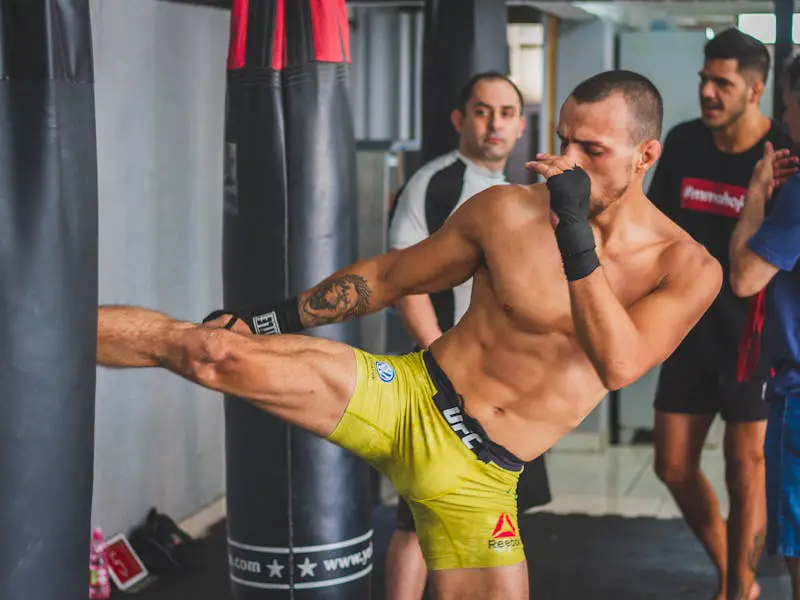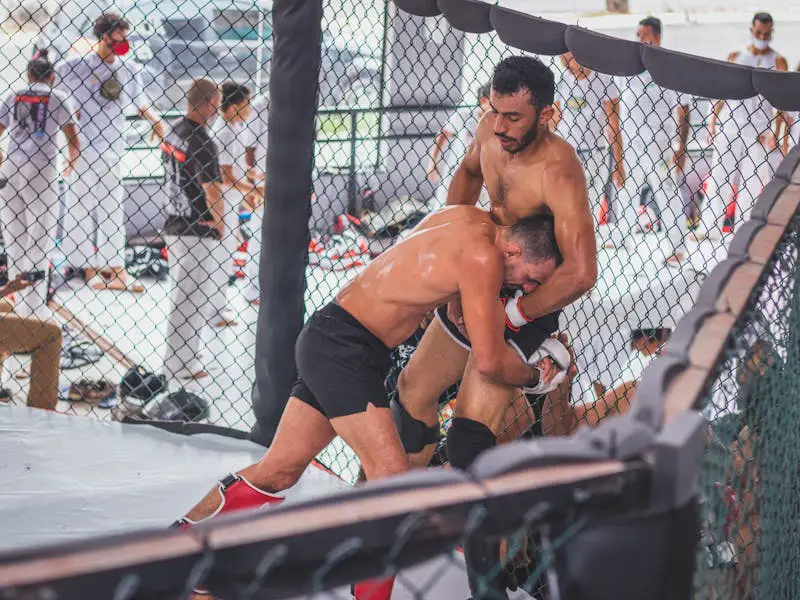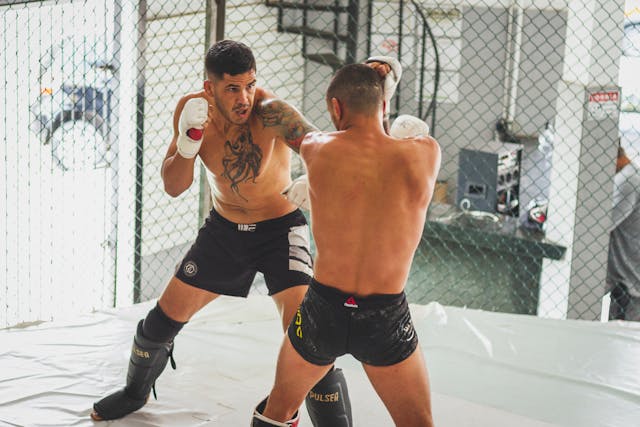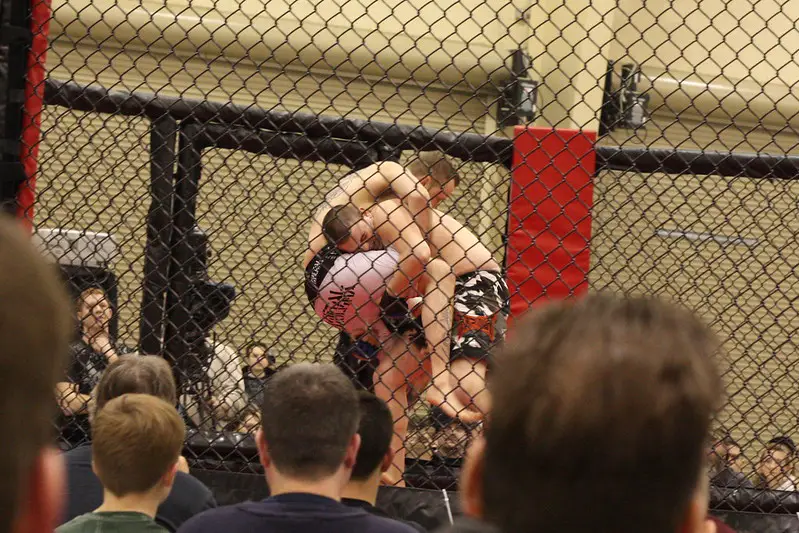Learning Mixed Martial Arts (MMA) quickly is a challenging task as it requires developing proficiency in multiple disciplines such as striking, grappling, and wrestling in a short time. However, with the right approach, training strategy, and motivation, you can learn MMA faster than the conventional way.
This doesn’t mean you will learn MMA quickly. No one can guarantee you that. But it will certainly boost your progress and enable you to maximize the efficiency of your time spent in the gym.
Step 1 – Find A Good Academy
If you want to learn MMA faster, then it is important to find the right gym. Look for places that have a good reputation and that have already produced pro fighters. How to find a good MMA gym is much easier these days if you follow this steps:
- Start by researching MMA gyms in your area. Use search engines, social media platforms, and online directories to compile a list of potential gyms.
- Look for reviews and testimonials from current and former members of the gyms on your list.
- Schedule visits to the gyms you’re interested in. Take a tour of the facilities, observe a class if possible, and speak with the instructors and staff members.
- Inquire about the credentials and experience of the instructors at each gym.
- Assess the gym’s facilities, including the condition of the training area, equipment, locker rooms, and amenities.
- Inquire about trial classes or introductory offers that allow you to experience training at the gym before committing to a membership.
- Consider the cost of membership and any additional fees associated with training at each gym. Ensure that the cost is reasonable and within your budget.
Once you’ve found some potential gyms, it’s crucial to consider the coaches and programs they offer. Experienced coaches can make a big difference in your learning journey. They’ll teach you the proper techniques and help you progress safely.
Structured programs ensure that you have a clear path for improvement. They’ll give you a roadmap to follow and keep you focused on your goals. So, when choosing a gym, prioritize places with good coaches and organized programs.
Be Patient And Master The Fundamentals
When it comes to learning MMA quickly, mastering the basics is crucial. Fundamental techniques form the foundation of your skills as a fighter. The better your base is, the faster you are going to adopt more complex moves.
They’re like the building blocks that you’ll build upon as you progress in your training. Without a strong grasp of the fundamentals, it’s challenging to advance to more advanced techniques.

For instance, neglecting the form can end up in bad habits. Although bad habits and tendencies might look easy to fix — they are not. Especially if you carry them into the advanced level of learning. It will force you to develop even worse later on and destroy your progress.
Many fighters then try to go back and correct these issues which takes a lot of time and effort they could have spent on progressing further.
So although it sounds odd, being patient and drilling the basics all over again until you master it to perfection is actually how you can learn MMA faster rather than jumping levels.
Hit The Gym As Often As You Can
If you want to learn MMA faster, training as much as possible is key. Try to practice at least 4 times a week if you are a beginner, and at least 5 to 6 times after a few months.
Having a schedule helps you stay organized and focused. Find out when you have free time and plan your training sessions around that.
If you can, join extra classes and go to open mat sessions. Open mat sessions are great because you can train with different people and learn new techniques. These extra classes enable you to train with senior students, maybe rol and spar with them, and discuss techniques and strategies.
Whether it’s BJJ, wrestling or MMA open session, be sure to attend as much as you can. The more you train, the faster you’ll progress in MMA.
Improve Core and Endurance
Physical conditioning is the foundation of any successful MMA fighter. It encompasses strength, speed, agility, and endurance — all of which are necessary for performing at your best during training and fights.
Your core muscles are central to almost every movement you make in MMA, from striking to grappling. Therefore, it’s crucial to incorporate exercises that specifically target your core muscles, such as planks, Russian twists, and medicine ball throws. These exercises not only strengthen your core but also improve your stability and balance, making you a more effective and resilient fighter.
Also, MMA training can be physically demanding, requiring high levels of endurance to endure intense workouts and sparring sessions.
By focusing on improving your cardiovascular fitness and stamina through activities like running, cycling, and interval training, you can increase your ability to sustain prolonged periods of exertion during training.
Regularly train with senior fighters
When you train with those who have more experience, you have the opportunity to learn directly from them.
They can provide valuable insights, tips, and corrections that you might not get otherwise. Additionally, being around skilled practitioners can push you to improve faster as you strive to keep up with their level of performance. But keep your ego in check, and accept you are going to “lose” but learn a lot.

Always keep in mind that senior students and pro-fighters can serve as mentors, guiding you along your journey in MMA. They can offer personalized advice tailored to your strengths and weaknesses, helping you to refine your techniques and overcome challenges.
They have been through the ups and downs of MMA competition and training, and their insights can provide invaluable lessons. Whether it’s sharing strategies for overcoming common obstacles or recounting their own successes and failures, their stories can offer invaluable wisdom that you can apply to your own journey in MMA.
Watch fight footage and tutorials
Watching fight footage and tutorials is like having a library of knowledge at your fingertips. You can find these resources online, on platforms like YouTube, or offline, through DVDs or books.
Take advantage of them.
When you watch, pay attention to how fighters move, how they use different techniques, and the strategies they employ to win. It’s like studying a game plan. Then, when you’re back in the gym, try to incorporate what you’ve learned into your own training. Practice those moves, refine your technique, and adapt those strategies to your own style.
The same stands for video tutorials. Nowadays, a lot of fighters and coaches are selling their MMA or skill-specific courses you can buy for a reasonable price. Consider getting one, it will certainly pay off. This active learning process will help you progress faster in MMA and become a more well-rounded fighter.
Pay extra attention to wrestling and BJJ
Paying extra attention to wrestling and Brazilian Jiu-Jitsu (BJJ) is crucial for success in MMA due to the significant role grappling plays in the sport.
Grappling forms the foundation of MMA, as it allows fighters to control and manipulate their opponents on the ground. The learning curve is much longer in grappling than in striking, which is why MMA fighters with a strong base in wrestling or BJJ have better chances of succeeding.

It is much easier for a grappler to develop solid striking than vice versa. So, be sure to dedicate extra time to wrestling and BJJ training sessions to at least develop a strong defense.
If you come into MMA without any base, it is likely that you are going to progress faster in striking while grappling is going to give you all kinds of problems.
So play a long game and focus on developing a strong grappling base right from the start. This includes attending specific grappling classes or sessions, where you can focus on developing your skills in takedowns, transitions, submissions, and ground control.
Do Home-Based Workouts
There are several effective MMA workouts that you can do to learn MMA faster. These workouts focus on improving cardio, strength, flexibility, and overall conditioning, essential for MMA training. Here are some examples:
- Shadow Boxing — is a fundamental MMA workout that helps improve footwork, punching combinations, and overall movement.
- Skipping (Jump Rope) — is a fantastic cardio workout that also improves footwork, coordination, and agility. Incorporate skipping into your routine for several minutes at a time, alternating between different styles such as single-leg hops, double unders, and side-to-side jumps.
- Shadow Wrestling/Grinding — Practice wrestling or grappling movements against an imaginary opponent. Focus on executing takedowns, sprawls, clinch work, and ground transitions.
- Heavy Bag Work – If you have access to a heavy bag, incorporate striking drills into your routine. Practice punching combinations, kicks, knees, and elbows on the bag, focusing on power, speed, and accuracy.
- Plyometric Exercises — Include exercises like box jumps, squat jumps, jump lunges, and explosive push-ups in your routine.
- Flexibility and Mobility Drills — Incorporate dynamic stretches, yoga poses, and foam rolling exercises to increase flexibility, loosen tight muscles, and improve range of motion.
Spar often (the smart way)
Sparring is not about going all-out to defeat your opponent. It is a tool for learning and refining techniques in a simulated combat environment. Approach sparring with a mindset focused on skill development, learning from your mistakes, and gaining experience in applying techniques under pressure.
When beginning your sparring journey, prioritize controlled, technical exchanges over full-contact combat. This allows you to focus on executing techniques with precision and timing without the added pressure of intensity.
Again, be patient and focus on the fundamentals.
As you become more comfortable with sparring, you can gradually increase the intensity while prioritizing safety. This means communicating with your training partners to ensure both parties are on the same page regarding the level of contact and intensity.
Moreover, always use appropriate protective gear, such as gloves, mouthguards, and shin guards, to minimize the risk of injury during sparring sessions. Remember that safety should always be a priority, and it’s essential to listen to your body and know your limits to avoid overexertion or unnecessary harm.
Recover and Stay Healthy
Recovery and maintaining good health are essential components of learning MMA quickly and effectively.
In MMA, training sessions can be intense and physically demanding and lead to:
- Increasing the risk of injury
- Temporarily suppress the immune system, making you more susceptible to illness and infections.
- Chronic fatigue and physical discomfort
By prioritizing recovery and maintaining good health, you reduce the likelihood of injuries that can impede your progress and sideline you from training. Also, including rest and proper nutrition, is necessary for muscle growth and repair, leading to increased strength, power, and endurance over time.
When your body is well-rested and nourished, you’re better equipped to perform at your best during training sessions, sparring, and competitions. This means that you can also be more productive in these sessions and learn MMA faster.
By staying healthy, you can prolong your career in MMA, continue learning and improving, and enjoy the benefits of martial arts for years to come.
Can You Learn MMA In A Year?
Yes, it’s definitely possible to learn Mixed Martial Arts (MMA) within a year, but the level of proficiency you achieve will depend on several factors. It is enough for a total beginner to master the basics, but not more than that.
If you have experience in related disciplines like boxing, Brazilian Jiu-Jitsu, Muay Thai, or wrestling, you may progress more quickly as you’ll already have a foundation in some of the fundamental skills.
Skilled wrestlers usually need a year to develop decent striking, and another year to learn how to mix it all together before starting to compete in MMA matches. The same stands for high-level jiu-jitsu fighters, especially no-gi who don’t need much time to adapt.
Muay Thai fighters and boxers need a bit more time because the learning curve is much longer in grappling. Depending on many individual factors, they need between 3 and 5 years to develop solid grappling defence before going into competition.
Of course, these are the rough numbers. No one can really come up with a more precise time period because it is all based on many factors. This includes talent, quality of coaching staff, etc.
How Long Does it Take to Learn MMA?
On average, practitioners without any martial art background need around 3 to 5 years of training to develop all-around skills. This includes the level needed to compete in amateur matches, and maybe start a pro career if you are talented enough.
Of course, the exact time is based on individual factors such as talent, dedication, gym quality and motivation.
If you’re starting from scratch with no prior martial arts experience, it may take longer to develop the necessary skills compared to someone who already has a foundation in disciplines like wrestling, Brazilian Jiu-Jitsu, Muay Thai, or boxing.
Wrestlers can transition quickly due to the importance of grappling in the sport. Strikers such as Muay Thai fighters can also make a fast transition, a bit slower than grapplers.
What is The Best Base For MMA?
Experts agree wrestling is the best base for MMA as most UFC champions have a strong wrestling background. The next is BJJ that has produced the second most champions before striking martial arts such as Muay Thai and Boxing.
However, the “best” MMA base can vary depending on individual preferences, strengths, and fighting style.
Practitioners who have a strong background in one of the following four martial arts tend to learn MMA faster than the ones without any background.
Brazilian Jiu-Jitsu (BJJ)
BJJ is renowned for its emphasis on ground fighting, submissions, and positional control. It teaches practitioners how to effectively neutralize opponents and submit them using joint locks and chokeholds. BJJ is invaluable for MMA fighters, as many fights end up on the ground where BJJ techniques can be highly effective.
Wrestling
Wrestling is another essential base for MMA, particularly for controlling opponents and dictating the pace of a fight. Wrestlers are known for their strong takedown abilities, superior clinch work, and top control on the ground. Wrestlers often excel in controlling where the fight takes place, whether standing or on the mat.
Muay Thai
Muay Thai, also known as Thai boxing, is a striking-based martial art from Thailand known for its powerful kicks, knees, elbows, and clinch work. It fits well within the rules of MMA striking because it trains you how to use all limbs in a fight and perform at all ranges including the clinch.
Boxing
Boxing focuses on punching techniques, footwork, head movement, and defensive strategies. Boxers are known for their precision, timing, and ability to generate power with their punches.
Final Thoughts on How To Learn MMA Faster
MMA is technically the most complex combat sport ever created. As such, it requires a lot of time, effort, motivation, and knowledge for one to go from being a total beginner to mastering the art of freestyle combat in a short period of time. However, the training methods are evolving at a high rate which means that with the right approach and program, you can learn MMA in a reasonable time.
The secret behind boosting your progress primarily lies in finding a legitimate school, spending as much time as you can on the mats, staying healthy and hungry, and embracing all the difficulties. Though this sounds logical and easy, it’s not. You must be persistent, resilient and have a strong mindset to endure all the challenges that will come your way.


